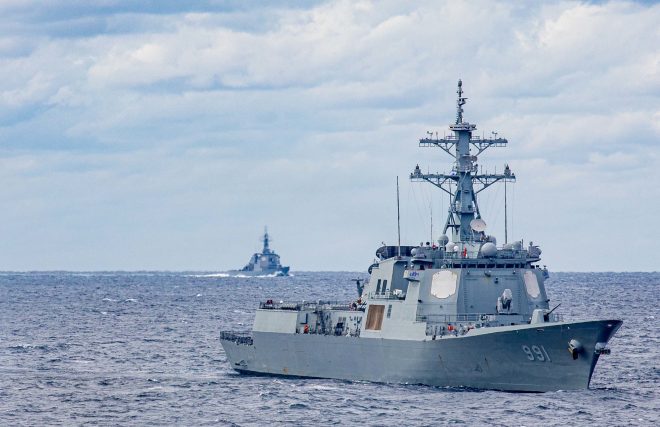
The United States, Japan, and South Korea announced on Tuesday that they have fully activated a real-time North Korea missile warning system and jointly established a multi-year trilateral exercise plan.
The announcement of the new arrangement follows North Korea’s launches of ballistic missiles on Sunday and Monday through the defense chiefs of the three countries; U.S. Secretary of Defense Lloyd J. Austin, Japan Minister of Defense Minoru Kihara, and South Korean Minister of National Defense Shin Wonsik had earlier agreed during the United States-Japan-Republic of Korea Trilateral Ministerial Meeting in November to finalize the two initiatives by the end of 2023.
A Pentagon release said the mechanism was now active following recent tests that verified the full operational capability of the DPRK missile warning data sharing. A multi-year trilateral exercise plan that will begin in early 2024 has also been established to build upon past trilateral exercises.
“These achievements and other ongoing efforts demonstrate the unprecedented depth, scale, and scope of trilateral security cooperation by the United States, the Republic of Korea, and Japan. The three countries will continue to build upon their cooperation to respond to regional challenges and ensure peace and stability on the Korean Peninsula, in the Indo-Pacific, and beyond” reads the release.
Meanwhile, Japan has bought forward the deployment of a new version of its in-service ground-launched variant of the Mitsubishi Heavy Industries (MHI) Type 12 anti-ship missile, intending to field it in Fiscal Year 2025 instead of the earlier planned deployment date of FY 2026.
Japan Defense Minister Minoru Kihara announced the new deployment schedule on Friday during his regular Friday press conference stating that the “acceleration is a realisation of the sense of urgency that Japan must acquire a practical stand-off defense capability as soon as possible”. He added that the Japan defense ministry was looking at other domestically produced and under development stand-off missiles to field them at an earlier date than scheduled.
The move comes about as part of an overall reassessment of the timeframe for deployment of Japan’s standoff weapon systems with the Kishida administration taking that the security environment around Japan has become more severe. Japan has already brought forward the date to introduce the Tomahawk cruise missile into Japanese service.
Japan’s major military concerns have been North Korea, China and Russia, North Korea’s ongoing efforts to improve its ballistic missile capabilities, China’s assertiveness in its territorial claims and Russia’s willingness to ignore the international community to continue its ongoing war with Ukraine. Those concerns combine with military cooperation between Russia and China – including joint activities near Japan has led to the Japanese government to move towards even earlier acquisition of long-range stand-off missiles. The acquisition of the Tomahawks are part of its counterstrike doctrine where Japan’s ability to launch a long range retaliatory strike would serve as a deterrent while other long range stand-off weapon systems would allow Japan to engage hostile forces from a distance, a Japan Ministry of Defense release on the accelerated improved Type 12 missile deployment stated that “the Ministry of Defense and the Self-Defense Forces are strengthening their stand-off defense capabilities in order to prevent and eliminate invading forces against our country at an early stage and from a distance”. China’s longstanding and ongoing claims on the Senkaku Islands held by Japan has led to Japan placing a priority of capabilities suitable for island defense against an invasion.
The improved Type 12 missile is to feature an improved range of over 900km compared to the current model’s 200km range along with a modified shape to reduce its detectability. Along with that, it would have a surface-to-surface capability allowing it to attack ground targets compared to the original version which only had an anti-ship capability. The ground-launched version is a launcher system carried by a truck. Work is also ongoing to improve the sea and air-launched versions of the Type 12. During the press conference Kihara said that the area where the improved Type 12 would be deployed initially had not yet been decided upon, he added that while the overall intention was to replace existing Type 12s in service with the improved version, there would be instances where the older versions would not be replaced, due to the fact that the increased range would not be required or could not be exploited due to conditions around the deployment area.
Earlier on Dec. 12, Japan’s Joint Staff Office (JSO) issued a release on the activity of the People’s Liberation Army Navy (PLAN) surveillance ship Tianshuxing (795) stating that on Dec.9 at 8 p.m., the PLAN ship was sighted sailing northwest in an area 140km northeast of Miyako Island and then sailed through the Miyako Strait to enter the East China Sea. Japan Maritime Self Defense Force (JMSDF) minesweeper JS Kuroshima (MSC-692) and a JMSDF P-1 Maritime Patrol Aircraft (MPA) of Fleet Air Wing 1 based at JMSDF Kanoya Air Base on the main island of Kyushu shadowed the PLAN ship, according to the release. The release also stated that Tianshuxing had on Nov. 30 sailed southeast into the Miyako Strait from the East China Sea and subsequently until Dec. 2 sailed around the waters west off Kume Island. On Dec.4, the PLAN ship sailed south through the waters west of Uotsuri Island which is part of the Senkaku Islands, and subsequently sailed south in the waters between Yonaguni Island and Taiwan.
A Friday release by the JSO stated that PLAN cruiser CNS Wuxi (104) was sighted at 6 a.m. that day sailing southwest in an area 50km of Tsushima and then transited the Tsushima Strait to enter the East China Sea. Fast attack craft JS Otaka (PG-826) and a JMSDF P-1 MPA of Fleet Air Wing 1 based at Naval Air Facility Atsugi on the main island of Honshu shadowed the PLAN cruiser. The release noted that earlier from Dec. 11-12, Wuxi had sailed northeast through the Tsushima Strait to enter the Sea of Japan.





